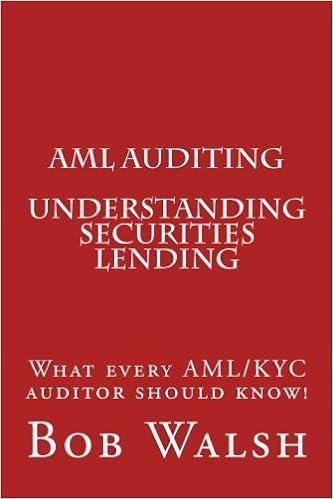








Use the following information to complete Problems 1, 2, 3, and 4 (all of which are on the next page; feel free to use this page to show your work) The following information is provided about a division for the year 2019: $500,000 Sales Variable expenses $390,000 Contribution margin $110,000 Fixed expenses $70,000 Operating income $40,000 Required rate of return 10% Assets at 1/1/2019 $150,000 Assets at 12/31/2019 $170,000 Problem 1 (8 points): What is the division's margin? Problem 2 (8 points): What is the division's asset turnover? Problem 3 (8 points): What is the division's return on investment? Problem 4 (8 points): What is the division's residual income? Problem 5 (10 points): A company incurs the following costs per unit in producing 30,000 units of Part XYZ annually. which is a part that is used in making its product. Direct materials Direct labor Variable manufacturing overhead Fixed manufacturing overhead Total product costs per unit $5.00 $3.00 $4.00 $6.00 $18.00 Instead of making Part XYZ, the company can purchase the part at a price of $14 per unit. The company has determined that 40% of the fixed manufacturing overhead can be avoided if the part is purchased. Additionally, if the company purchases Part XYZ, it can generate rental income of $25,000 annually by renting out the space in the factory that is currently being used to make the part. What would be the effect on profitability if the company decides to purchase Part XYZ, compared to continuing to make it? Use the following information to complete Problems 6, 7, 8, and 9 (all of which are on the next page; feel free to use this page to show your work) A company produces products A, B, C, and D, each of which can be sold at an intermediate phase of production or can be processed further to make a more refined product. Information about the company's products follows: Product Costs incurred to get product to intermediate stage Sales value at intermediate stage Additional processing costs Sales value at completion $45,000 $40,000 $15,000 $50,000 B $5,000 $3,000 $32,000 $42,000 $20,000 $24,000 $12,000 $46,000 D $14,000 $16,000 $17,000 $30,000 Problem 6 (4 points): What would be the impact on profitability of processing Product A into a more refined product, compared to selling it at the intermediate stage? Problem 7 (4 points): What would be the impact on profitability of processing Product B into a more refined product, compared to selling it at the intermediate stage? Problem 8 (4 points): What would be the impact on profitability of processing Product C into a more refined product, compared to selling it at the intermediate stage? Problem 9 (4 points): What would be the impact on profitability of processing Product D into a more refined product, compared to selling it at the intermediate stage? Problem 10 (8 points): A company produces chemicals that it sells to companies that produce cleaning products. The company has 20,000 gallons of Chemical C can be sold for $60,000 or can be processed further into Chemical D. If the company decides to process Chemical C into Chemical D, they will lose 15% of it in the process. The sales value of Chemical D is $6 per gallon, and the additional processing cost is $37.500. If the company decides to process Chemical Cinto Chemical D, what would be the effect on profitability? Use the following information to complete Problems 11 and 12 (both of which are on the next page; feel free to use this page to show your work) A company has received a request for a special order for 2.500 units of its product and the potential customer has offered to pay $130 per unit. Currently, the company produces 40,000 units monthly and the normal selling price for each unit is $190. The cost per unit for the 40,000 units produced monthly is as follows: Variable product costs Fixed product costs Variable selling and administrative expenses $80 $20 $12 Problem 11 (8 points): Assuming the company has a production capacity of 45,000 units monthly, what would be the effect on profitability of accepting the special order? Problem 12 (8 points): Assuming the company has a production capacity of 40,000 units monthly, what would be the effect on profitability of accepting the special order? Problem 13 (13 points): A company produces 4 products. The company's fixed costs amount to $150,000 per month. The following other information is provided: Product 1 Product 2 Product 3 Product 4 Price 80 60 Variable cost per unit 28 55 Monthly demand in units 12,000 10,000 16,000 11,000 Machine hours required per unit 0.75 2.0 3.0 40 70 50 45 2.5 The company has 50,000 machine hours available during the month. In order to maximize profitability, how many units of each product should the company produce during the month? Problem 14 (10 points) Burger World is a restaurant with 3 different restaurant locations: Atlanta, Boston, and Seattle. The company allocates common fixed costs equally to each location. The company's total operating income during the year 2019 was $218,000. Information about the restaurant locations from the year 2019 follows: Total Sales Total Variable Costs Traceable Fixed Costs Common Fixed Costs Total Operating Income Atlanta $300,000 $210,000 $86,000 $14,000 -$10,000 Boston $500,000 $200,000 $40,000 $14,000 $246,000 Seattle $210,000 $150,000 $64,000 $14,000 -$18.000 Suppose that the Atlanta restaurant location were eliminated at the beginning of the year 2019. That is, assume that during the year 2019 the company only had the Boston and Seattle restaurant locations. What would total operating income have been for the year 2019
















